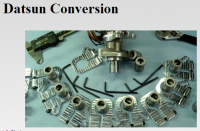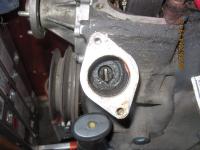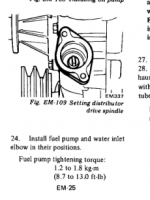Everything posted by Zed Head
-
Epic fail
Any chance you could take a look at the bottom edge of the cylinder? Still curious about what caused the rod to punch a hole in the block.
-
oh hey, I forgot to put this part in.... tranny swap
Did you swap a manual for a manual? So the old pilot bushing is still installed? Might not be a huge problem, but the nose of the mainshaft on the old transmission will give a clue. If it's dry and worn then the pilot bushing probably is too. If it's smooth and lubricated the old one might be okay. That bearing noise is pretty common. The bearings used are generally loose (C3) and noisy. People have reported doing lots of work to quiet things down only to have the noise come back almost immediately with brand new bearings. The noise might be more apparent now that you're hyper-sensitive to transmission problems. Every transmission I've had in my car (four total) makes that noise that goes away when the clutch is disengaged.
-
Modern injectors, new fuel rail - no heat soak problem
Just another update for those with The Problem. I haven't had a single hot start issue since that one weird episode mentioned above (somewhere). We've had some hot weather here and I drive my car almost every day, multiple trips. It's great to finally have a normal car that I can get in and out of without turning on timers or waiting for the engine to settle down after starting. Still hoping for more feedback from anyone using the FJ707 or FJ3 injectors, with stock exhaust manifolds.
-
Click, Click, Click: from under the dash while coasting
I've had the clicking under the dash and it was the fuel pump relay being kicked on and off by the AFM switch. I believe that I removed the clicking by adjusting the metal arm in the AFM to where the AFM vane could close farther before hitting the switch. But the low RPM on closing the throttle still happens, when the engine is between cold and fully hot. I found that the RPM drop got worse as I advanced my timing set point, and since I removed the other pickup coil that kept timing advanced while cold (that's contradictory but idle speed has to be reduced after advancing the static timing, the second pickup coil was for cold engine only, run off of a temperature switch). At this point I just live with it during warm up, since the engine doesn't die and it's only there for a few minutes. After the engine gets warm the issue goes away. The dash pot adjustment helped, but it lasts for longer than the dash pot can stay up. It still bobbles around at ~600 RPM for a second, when the engine is cold and the AAR has closed before rising to 900-1000. It's a weird thing, I think it might have to do with cold air and fuel. Maybe the cold enrichment formula in the ECU is off or, the 10% ethanol in the gasoline is screwing things up. Newer cars control idle speed via the ECU by changing timing and/or an idle air control valve (edit - actually called an idle air adjusting (IAA) unit. Idle air control is our AAR. Browsing my other car's manual).
-
Clutch making crazy loud noise
Most are sealed bearings, I believe, and pre-lubed. But who knows, you could get a dry one. Another test that you could do is to push the slave cylinder rod in and disconnect it from the clutch fork completely. Then, with the engine running you can push the clutch fork back and forth by hand to see what effect it has on the noise. You'll be able to get it completely off of the bearing face, and also apply pressure. You'll be able to feel what's happening also through the fork. Here's a video I found about TOB noise. I don't really like his explanation of the fix though, it doesn't make sense. And here's a general description of a company's bearing. Pre-lubed. Hays Throwout Bearings - Free Shipping on All Orders @ JEGS
-
Very Cool Ignition Upgrade
That mount or adapter is the piece that 123 USA (probably ED0 had designed and manufactured to make the 123 distributor a bolt-in piece. Prior to that, not too long ago, they suggested that people build their own. Ed probably got a minus tolerance, or worn, shaft to use for his dimensioning and they made a bunch of minus tolerance pieces.
-
gas is not so much gas anymore
I believe that the push toward using ethanol in gas really started when the US was trying to gain oil independence since we weren't developing oil supply here. That's also the reason behind the new oil fields in North Dakota and the shale-oil and the fracking. The corn lobby is just one of several trying to gain advantage in the situation, and added some lies like many PAC's do, about how it's a natural product and good for the environment and carbon-neutral. The government institutions have no reason to debunk the BS since it helps their efforts to be more energy independent. That video is amusing but the idea that "grit" is transferred from the corn that the ethanol is produced from is nonsense (no offense to anyone that thought it sounded reasonable). The ethanol is distilled, no solid material comes along for the ride. If it did, you'd find grit in your bourbon. And burning ethanol-containing gasoline on a table, under no compression is not representative of inside an engine. Anyone with an old car or engine is kind of screwed since the government's decisions are based on what's good for the masses. I'm not saying it doesn't screw up old engines, only that there's a lot of nonsense out there. The nonsense is great for the borderline repair shop as a tool to explain why you need to replace a bunch of parts on your engine. The more confusing, the better.
-
oil pressure releif valve---please help
It's the thing that holds the big ball bearing, under the filter. Image of it removed, way below. BUT, your problem might be in the filter itself. Anti-Drainback Valve. Some oil filter mountings may allow oil to drain out of the filter through the oil pump when the engine is stopped. When the engine is next started, oil must refill the filter before full oil pressure reaches the engine. The anti-drainback valve, included in the filter when required, prevents oil from draining out of the filter. This anti-drainback valve is actually a rubber flap that covers the inside of the inlet holes of the filter. When the oil pump starts pumping oil, the pressure will unseat the flap. The purpose of this valve is to keep the oil filter filled at all times, so when the engine is started there will be an almost instantaneous supply of oil to the engine. FAQs| FRAM Datsun 240Z Oil Pressure Relief Valve, 260Z 280Z 280ZX
-
Epic fail
I've never considered the failure mechanism for a "thrown" rod but it looks like the wrist pin breaks free from the piston, leaving the piston pieces in the bore, then the rod is smashed through the side of the block by the crankshaft on the next up stroke. Is there any damage to the skirts at the bottom of the bore? It seems like that would be the fulcrum, or ramp, to redirect the rod sideways. If the rod came off the big end first it seems like it would just get pounded up the bore and stay there with the piston. That's why I thought that there would be head damage.
-
77 280Z Dropping Fuel Pressure once Warm
Sorry for the bad advice. If you had a pile of spare parts like I do you could have double-checked the FPR. Thinking back, people have had cases where something loose in the tank covers up the screen on the outlet port of the tank. Either rust particles or gas tank sealer or just junk that ended up in the tank. Then when the pump turns off it floats away, and the cycle starts over. I would let the pump run on battery power in the garage, without the engine running, and just listen. You'll hear a change in pitch from the pump if there's something happening back there. Then crawl underneath and run a line to an external tank. Do the same thing. If the pump runs fine for extended time on the external tank, but not the car's tank, you'll know where the problem is. Forgot to say - make sure your gauge is good. They go bad. #5 and #6 here - http://www.classiczcars.com/forums/fuel-injection-s30/52413-78-no-start-w-out-fuel-priming.html#post457924
-
78 No-Start w/out Fuel Priming
Even though your engine does eventually start and, apparently, runs well once it starts, the 30+ psi is out of spec. It should be 36-38 psi when priming. That's not a huge difference but could be a factor. Or not. It could also be that you have a vacuum leak and that plus the low fuel pressure is leaning out things enough to give a no-start. A small vacuum leak will have bigger impact at low RPM because it's a larger proportion of total air flow. You've blocked the EGR but maybe you missed a port, or the seal is not good. Maybe get the engine running and use some carb cleaner or starting fluid to check for a vacuum leak. Have you adjusted the AFM spring, or installed a potentiometer in the coolant sensor circuit? That might compensate for the low fuel pressure during running but not the start problem.
-
Is this off too much?
I agree completely with verifying that everything's in alignment and orientation. And that there is a pretty wide range of adjustment on the distributor. But I think that picture that you posted is a product of that range of adjustability. It's not the stock setup, it's something that's been made to work. It's a variant. Better to follow the FSM for a stock setup, otherwise you could be dropping the oil pump and making adjustments for the wrong reason.
-
very original 72
It says the care came from Arkansas but doesn't say where it is now. As far as I can see on the eBay ad.
-
Is this off too much?
Here's a picture of the greasy tang on my old original 1976 engine, at zero, sitting in the garage, headless. Y'alls picture is just too shiny. We've got three that show a different orientation. siteunseen's, mine and the FSM. Not sure where that shiny picture is from or why it would be different. Just saying, something's off, somewhere.
-
Wiper motor and jets are not working on my 72 240z
The funny thing is I posted all of this in the wrong thread. Had two open at the same time. Sorry. I'll see what I can fix.
-
Wiper motor and jets are not working on my 72 240z
Mistake.
-
Wiper motor and jets are not working on my 72 240z
Mistake. Wrong thread.
-
I need some dimensions or pic moustache bar area
After you do some experiments you'll see why someone took the time to mold a new bushing. Even if you get the up and down part tightened up, there's still the side to side. The only problem with the urethane bushing kits is that they made the sleeve too short, allowing the nuts and washers to compress the bushings too tightly, passing more noise from the diff. If I was installing a new kit, I might just get a piece of metal pipe and make my own sleeve, of an improved length. It's a shame that once these things get in to production, mistakes and all, they never change. Most aftermarket parts are really just good starting points.
-
Is this off too much?
Everything looks great, assuming that the tight side (driver's side) of the timing chain is tight, and you're on zero. Can't really see the picture, it's too dark. You can put a wrench on the cam sprocket nut to tighten up the tight side, if it's off a little. The numbers don't really matter, it's the notch and groove that do. Yours look right.
-
I need some dimensions or pic moustache bar area
I think that if the rubber compressed you did it right. Worth a test drive. Not sure what you mean by did it wrong, unless you're talking about the slight change in diff angle. A test drive will tell you if the clunk is gone, even if you have a new misalignment noise.
-
I need some dimensions or pic moustache bar area
This is exactly what I did when I was dealing with loose diff problems. It helped with the thud/clunk. but did add a little high frequency noise from the diff, the more wahers, the worse the noise transfer. But it did give me the idea to find some washers that effectively added length to the sleeve that comes with the poly bushing. My current setup has the poly bushings in the mustache bar but the lengthened center sleeve, using washers that fit inside the urethane bushing hole, but are the same outer diameter as the sleeve material, and fit pretty tightly on the post. I think that they are called AN washers. ACE Hardware. So there's a fraction of an inch of wiggle room for the bar, but under load it gets taken up. I never had the fully compressed urethane bushings, or new stock rubber, so don't know what they sound like. But mine is much quieter than the old worn out parts.
-
I need some dimensions or pic moustache bar area
Your bushing rubber looks in better shape than many I've seen. The washers are supposed to bottom out on that inner sleeve. It leaves the bar kind of hanging in between, with the web of rubber of the bar bushing supporting the weight. The scalloped layer of rubber on the washers is more of a final damper for any movement. That's my take on the design. I think that the idea is to minimize pathways for the high frequency vibration. The diff howl. But the rubber gets weak over time. If you've compared a new rubber transmission or diff mount to an old one you can really see the difference in rubber stiffness. I've had good luck with the urethane mounts, with 2-3 washers added to the inner sleeve to leave a small air gap between the urethane and the washers. Basically, extending the sleeve length. The same general concept of the Nissan design. A little bit of float. My diff noise is less than when I got the car and had old worn clunky stock mounts. I had clunk and howl, pretty bad for both. I also have a an RT-style front mount now. I think that most of the urethane mustache bar bushings are designed to clamp the bar tightly, race-car mentality, and transmit a lot of vibration to the body. That's why they tend to be noisy. Another opinion. Maybe try some new mounts or get a another bar for experiments. Forgot to say also, that the bar can move side to side on the mounting posts. The bushing rubber in the mustache bar ends is not solid, it's a web.
-
Clutch/Tranny Noise
I'm using a Rhinopac OEM-style clutch. Easy engagement, light pedal, no problems with holding power (stock engine and 205 tires). A very smooth replacement part. I would buy another. My old Zoom Perfection OEM-style clutch had a stiff engagement and chattered when it got hot. I will avoid in the future. I bought both new, and used them on non-resurfaced flywheels (cheap, not recommended practice).
-
I need some dimensions or pic moustache bar area
Is there play in the mustache bar bushings? Can't tell if you're using urethane or stock rubber. When you hit the gas the front of the diff lifts up and the back, with the mustache bar, gets pressed down. Pivoting around the axles. Maybe you're hearing the mustache bar bottom out on the washer and bolt at the end of the mounting shaft. You could probably tell by grabbing the bar and checking play, from underneath..
-
Hot-start issue with EFI - who has it, who doesn't
You have the same setup as siteunseen. Header and FJ707T injectors. That's two wins for that combination, but still leaves the question of header or injector. Here's something generally interesting on injectors. BWD and Standard are made by the same organization, and the high end BWD's have the FJ type of output (see links below). When I bought my first set of new injectors, I went for the cheaper ones,with the single pin pintle design, like Nissan stock. A few more dollars and I might never have had the problem, assuming injectors alone are the solution. The price difference seemed higher back then. List: Fuel Injector - 1978 Nissan 280Z | O'Reilly Auto Parts BWD 57519P - Fuel Injector | O'Reilly Auto Parts Edit - I shouldn't leave out FastWoman's Standard FJ3 injectors either, with stock manifold and heat shields (but a wrapped/insulated fuel rail). Reported to have occasional hot start issues, but not significant, if I recall correctly. That's three FJ injector winners, no FJ losers yet.






